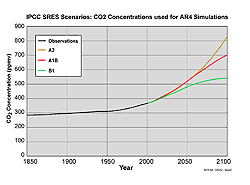In 2004, approximately 25% of the available computing resources of "HLRE1", DKRZ's former Supercomputer (thus 6 NEC SX-6 nodes operating 24 hours a day), were used for complex model calculations whose results contributed to the the fourth Assessment Report (AR4) of the "Intergovernmental Panel on Climate Change" (IPCC) published in 2007. In such Assessment Reports by the IPCC (see also www.ipcc.ch), published every 5 years, the actual knowledge on the state and the expected changes of climate are summarized.
| The figure displays three different scenarios for the CO2-concentration based on different assumptions for emissions which are controlled by different economic and political developments. Though not shown here - but considered within the simulations - there are also other greenhouse gases and aerosols. |
The simulations were performed with the coupled atmosphere ocean model ECHAM5 / MPI-OM, developed at MPI-M. The atmospheric model component ECHAM5 has a horizontal resolution of approximately 200 km with vertically 31 model levels. The ocean model MPI-OM is used with a regionally varying horizontal resolution between approximately 10 km and 150 km.
The results of the simulations, carried out for the German community by the Max Planck Institute for Meteorology (MPI-M) and the Model and Data Group, were operationally stored in a relational database. They are available to scientists for further analysis. The model output of the new IPCC simulations, which were stored until the beginning of 2005 in the climate database, amount to more than 120 TeraBytes, thus 120,000 GigaBytes! The data are made available by the World Data Center for Climate (WDCC) and can be accessed at https://cera-www.dkrz.de/WDCC/ui/cerasearch/.
The results of the climate change simulations for different emission scenarios have given rise to particular public interest. How will the climate develop in the next 100 years?

